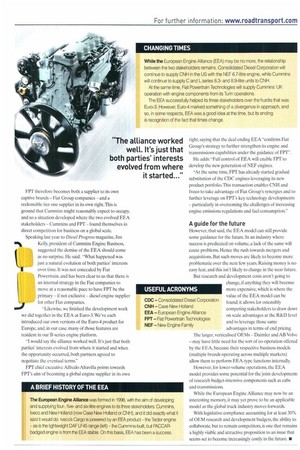Victim of its own success
Page 48

Page 49

If you've noticed an error in this article please click here to report it so we can fix it.
In a world where success is predicated by scale, what went wrong (and right) at the European Engine Alliance?
Words: Otiver Dixon Merger and acquisition talk is nothing new in today's automotive industry. It is a strange week when no such rumour or innuendo does the rounds, and a strange month in which a deal of some sort doesn't go through.
As such, the announcement in July last year that the European Engine Alliance (EEA) was to be effectively wound down — with the European business going to Fiat Powertrain Technologies (FPT) and the US arm. Consolidated Diesel Corporation (CDC), finding a home with Cummins — was significant. Demergers shouldn't happen in a business where success is predicated on scale, so why did EEA come to nothing?
Ironically EEA has, arguably, proved to be a victim of what it sought to exploit. When the Alliance was formed, it aimed to leverage the considerable volumes that would accrue from supplying the engine demands of each of the three stakeholders. However, those three stakeholders have also been developing their own respective internal and external volumes. and have been seeking to leverage those, too. Effectively, the FEA found itself in competition with itself.
Contradictions
In many respects, this contradictory situation developed almost immediately after the inception of EEA. New Holland's owners — Fiat — bought Case in 1999, and immediately changed its volume dynamic. It was the formation of FPI' in 2005, and the vesting of Iveco's engine and powertrain activities in the new operation, that rendered EEA untenable.
FPT may have been set up as a means to supply Fiat Group firms with their engine demands, but was also keen to supply external customers. A deal between the Italian corn pany and Daimler subsidiary Fuso in 2007 will see FPT supply the Japanese OEM with 80,000 light-duty diesel engines a year, starting this year. FPT therefore becomes both a supplier to its own captive brandsFiat Group companies and a reckonable tier one supplier in its own right. This is ground that Cummins might reasonably expect to occupy, and so a situation developed where the two evolved EEA stakeholders Cummins and FFT found themselves in direct competition for business on a global scale.
Speaking last year to Diesel Progress magazine, Jim Kelly, president of Cummins Engine Business, suggested the demise of the EEA should come as no surprise. He said: "What happened was just a natural evolution of both parties' interests over time. It was not concealed by Fiat Powertrain, and has been clear to us that there is an internal strategy in the Fiat companies to move at a reasonable pace to have FPT be the primary if not exclusive diesel engine supplier for other Fiat companies.
-Likewise, we finished the development work we did together in the EEA at Euro-3. We've each introduced our own versions of the Euro-4 product for Europe, and, in our case. many of those features are resident in our B-series engine platform.
would say the alliance worked well. It's just that both parties' interests evolved from where it started and when the opportunity occurred, both partners agreed to negotiate the eventual terms."
FPT chief executive Alfredo Altavilla points towards EPT's aim of becoming a global engine supplier in its own right, saying that the deal ending EEA "confirms Fiat Group's strategy to further strengthen its engine and transmissions capabilities under the guidance of EFT".
He adds: "Full control of EEA will enable EFT to develop the new generation of NEF engines.
At the same time, EFT has already started gradual substitution of the CDC engines leveraging its new product portfolio.This transaction enables CNH and iveco to take advantage of Fiat Group's synergies and to further leverage on EPT's key technology developments particularly in overcoming the challenges of increasing engine emissions regulations and fuel consumption."
A guide for the future
However, that said, the EEA model can still provide some guidance for the future. In an industry where success is predicated on volume, a lack of the same will cause problems. Hence the rush towards mergers and acquisitions. But such moves are likely to become more problematic over the next few years. Raising money is no easy feat, and this isn't likely to change in the near future.
But research and development costs aren't going to change, if anything they will become more expensive, which is where the value of the EEA model can be found: it allows for ostensibly competing stakeholders to draw down on scale advantages at the R&D level and to leverage those same advantages in terms of end pricing.
The larger, verticalised OEMs Daimler and AB Volvc may have little need for the sort of co-operation offered by the EEA, because their respective business models (multiple brands operating across multiple markets) allow them to perform EEA-type functions internally.
However, for lower-volume operations, the EEA model provides some potential for the joint development: of research budget-intensive components such as cabs and transmissions.
While the European Engine Alliance may now be an interesting memory. it may yet prove to be an applicable model as the global truck industry moves forwards.
With legislative compliance accounting for at least 30% of OEM research and development budgets. the ability to collaborate, but to remain competitors, is one that remains a highly viable and attractive proposition to an issue that seems set to become increasingly costly in the future. • —
















































































































































